


xxxxxThe works of the Frenchman Auguste Rodin, one of the world’s foremost sculptors, attracted controversy from his first major work, The Age of Bronze in 1877. Having visited Italy two years earlier and come under the influence of Michelangelo, he produced a string of figures and groups which broke away from the idealised statues of antiquity and the Baroque period, then much in favour. He sought to capture, through texture and modelling, the human strengths and weaknesses of his subjects, not merely a reproduction of their physical form. His was a psychological study, not simply an attempt at a superficial likeness. This “expressive naturalism” can be seen in such works as John the Baptist Preaching, the Burghers of Calais and two of his most famous works, The Thinker and The Kiss of 1886, both taken from his major undertaking, The Gates of Hell. His monuments of Victor Hugo and Honoré de Balzac also involved him in a great deal of controversy, but by 1900 he had gained international recognition as a sculptor of rare ability. Apart from thousands of figures and busts, he painted in oil and watercolour, and produced a vast number of drawings. His friends included the impressionists Monet and Cézanne, and the writers William Henley, Robert Louis Stevenson and Robert Browning, and he much admired the works of the French poet Baudelaire.
AUGUSTE RODIN 1840 - 1917 (Va, Vb, Vc, E7, G5)
Acknowledgements
Rodin: by the French photographer Paul Nadar (1856-1939), 1891 – Collection Kharbine-Tapabor, Paris. Rodin’s Work: Vanquished: 1877, Musée Rodin, Paris; Gates of Hell: plaster, Musée d’Orsay, Paris; The Thinker: 1880, Musée Rodin, Paris as from 1922; The Kiss: Musée Rodin, Paris as from 1918; Burghers: 1888, in front of Town Hall, Calais, since 1926; Balzac: 1898, Jardin du Musée Rodin, Paris; Old Woman: 1887, Musée Rodin, Paris; Hugo: completed 1883, Musée Rodin, Paris; Ballet Dancer: 1910, Hayhill Gallery, London. Claudel: Deep Thought, 1898, location unknown. Rosso: Laughing Child: image published in the Berlin weekly magazine Illustrirte Zeitung, 1902 – private ownership; Caretaker: 1883 – Galleria d’Arte Moderna, Florence, Italy; Self-Portrait: Casa Museo Remo Brindisi, Italy.
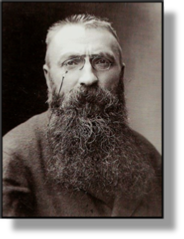 xxxxxAuguste Rodin, the foremost sculptor of the 19th century and early 20th century, was born in Paris, son of a clerk in the city’s police department. From early childhood he showed a marked ability at drawing, and at the age of 14 attended La Petite École, a school specialising in the training of craftsmen and decorative artists. He showed promise at this stage, notably in sculpture, but on completing his training in 1857 he made three unsuccessful attempts to gain entrance to the École des Beaux Arts, and was finally obliged to go out and earn a living. Forxthe next thirteen years he worked as an assistant to a number of decorators and ornamentalists, including the French sculptor Ernest Carrier-Belleuse (1824-1887), and progressed from decorative stonework to the sculpting of figures. In his own time he attended a free school for artisans, studied antique sculpture at the Louvre, and took classes in anatomy at the School of Medicine.
xxxxxAuguste Rodin, the foremost sculptor of the 19th century and early 20th century, was born in Paris, son of a clerk in the city’s police department. From early childhood he showed a marked ability at drawing, and at the age of 14 attended La Petite École, a school specialising in the training of craftsmen and decorative artists. He showed promise at this stage, notably in sculpture, but on completing his training in 1857 he made three unsuccessful attempts to gain entrance to the École des Beaux Arts, and was finally obliged to go out and earn a living. Forxthe next thirteen years he worked as an assistant to a number of decorators and ornamentalists, including the French sculptor Ernest Carrier-Belleuse (1824-1887), and progressed from decorative stonework to the sculpting of figures. In his own time he attended a free school for artisans, studied antique sculpture at the Louvre, and took classes in anatomy at the School of Medicine.
xxxxxIn 1864 Rodin produced his first major work, a bust entitled The Man with the Broken Nose - inspired by the facial features of a local handyman. He submitted it for exhibition at the Salon, but it was rejected. In its form it was characteristic of ancient Greek art, but the subject matter proved quite unacceptable. However, disappointment was somewhat tempered by the fact that it was in this year that he met a seamstress named Rose Beuret. She became his model, mistress and life-long companion, despite periods of infidelity on his part. Inx1870 he went to Brussels with Carrier-Belleuse to work on a number of public monuments, and then assisted the Belgian artist Antoine-Joseph Van Rasbourgh (1831-1902) in providing architectural sculpture for the city’s impressive Stock Exchange. The six years spent in Belgium were valuable, creative years. And it was during this period, in 1875, that he paid a two-month visit to Italy - staying in Florence, Rome, Naples, and Venice - and became completely bowled over by the works of the Renaissance sculptor Michelangelo. The latent power and energy of these works served to create his own distinctive genius. He later wrote “Michelangelo freed me from academism (current teaching)”

xxxxxRecognition of Rodin’s artistic ability came in 1877 when his young male nude entitled The Vanquished (illustrated) - later called The Age of Bronze - was exhibited at the Salon. It caused a scandal. Such was the quality of its realism that for some time he was accused of making plaster casts from a live model. It was just the first of many public controversies which his works were to arouse during his career. In the following year he produced his St. John the Baptist Preaching, a larger than life figure to thwart any ideas of cheating. Though roundly condemned for its nudity and dismissed as ugly and improper, this statue, exhibited in 1880, confirmed his status as a sculptor of rare ability.
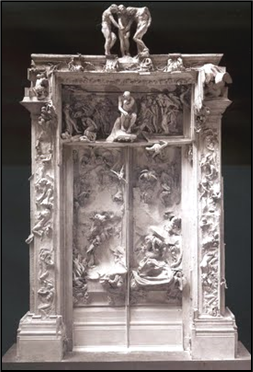 xxxxxIn the same year he began work on The Gates of Hell (illustrated), a monumental bronze door, commissioned by the French government for the planned Museum of Decorative Arts in Paris. Doubtless inspired by Ghiberti’s bronze doors of 1423 (H6), he originally took as his theme Dante’s Inferno, but, following a visit to London in 1881, during which he saw many Pre-Raphaelite paintings and drawings inspired by Dante - as well as the mystical works of the poet William Blake - he extended the subject matter to portray the torments of love, pain and death. This project, nearly 20ft (6m) high and over 13ft (4m) wide, and containing 186 figures, occupied him for the rest of his life and remained unfinished at his death. However, from it he did create a number of independent figures and groups. Among these were the first version of The Thinker in 1880 (illustrated below), a powerful, emotional work - possibly intended as a seated portrait of Dante above the gates - , Adam and Eve (1882), the first sinners, and The Kiss of 1886, a sensuous marble sculpture, originally based on the story of the ill-fated Paolo and Francesca in Dante’s Inferno (illustrated below). This and other mildly erotic works shocked the public and drew attention to the scandals of his own private life.
xxxxxIn the same year he began work on The Gates of Hell (illustrated), a monumental bronze door, commissioned by the French government for the planned Museum of Decorative Arts in Paris. Doubtless inspired by Ghiberti’s bronze doors of 1423 (H6), he originally took as his theme Dante’s Inferno, but, following a visit to London in 1881, during which he saw many Pre-Raphaelite paintings and drawings inspired by Dante - as well as the mystical works of the poet William Blake - he extended the subject matter to portray the torments of love, pain and death. This project, nearly 20ft (6m) high and over 13ft (4m) wide, and containing 186 figures, occupied him for the rest of his life and remained unfinished at his death. However, from it he did create a number of independent figures and groups. Among these were the first version of The Thinker in 1880 (illustrated below), a powerful, emotional work - possibly intended as a seated portrait of Dante above the gates - , Adam and Eve (1882), the first sinners, and The Kiss of 1886, a sensuous marble sculpture, originally based on the story of the ill-fated Paolo and Francesca in Dante’s Inferno (illustrated below). This and other mildly erotic works shocked the public and drew attention to the scandals of his own private life.
xxxxxHis undertaking of The Gates of Hell gave him the use of two workshops, freed him from any money troubles, and brought him a succession of commissions for public monuments. But his works continued to be highly controversial, and many brought him into conflict with the art establishment, the public, and, at times, Parliament itself. The large bronze group entitled The Burghers of Calais, completed in 1888 but not dedicated until 1895, is one of his best known works of this period (illustrated below). Produced to commemorate, as we have seen, an incident in 1347 during The Hundred Years’ War, it is truly remarkable for the differing psychological studies of the six men as they shuffle towards their execution (as they then thought). No mock heroics here, but a genuine, moving portrayal of the event, captured in depth. But It was not fully appreciated at the time.
Vc-1881-1901-Vc-1881-1901-Vc-1881-1901-Vc-1881-1901-Vc-1881-1901-Vc-1881-1901-Vc
xxxxxThe Italian sculptor Medardo Rosso (1858-1928) was a one-time friend of Auguste Rodin, and in some respects their work was similar. Like Rodin, he rejected the traditional subjects imposed by the art establishment, and his technique included a strong element of Impressionism. In attempting to capture random glimpses of everyday life - such as Man Reading and Conversation in a Garden - he subordinated detail to texture. Maintaining that “all is a question of light”, he gave his works a rough finish to capture the effects of light and shadow and create thereby the illusion of life and movement. His figures, sketch-like in quality, were seen as in a momentary glance, and some of his works fused figure and background together in order to relate the subject to its surroundings. By using wax over plaster he gave a translucent effect to his figures, and this heightened the emotional content. He was a close friend of Edgar Degas, but his friendship with Rodin came to an end in 1898 over accusations that Rodin had learnt certain aspects of his technique from the Italian.
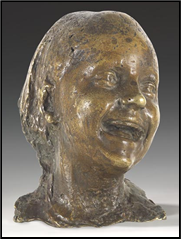
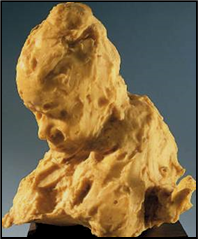 xxxxxA contemporary sculptor who was a friend of Auguste Rodin for a time, and shared some aspects of his innovative style, was the Italian Medardo Rosso (1858-1928). Rejecting, like Rodin, the traditional subjects imposed by the art establishment, he also introduced an element of Impressionism into his work. Keeping to everyday, mundane subjects - such as Man Reading, Lovers in the Lamplight, The Urchin and Conversation in a Garden - his figures had an unfinished, sketch-like quality as though seen in a momentary glance. And by concentrating on rough texture rather than minute detail, he accentuated the immediate effects of light and shadow, thereby creating the illusion of life and movement. “It is all a question of light”, he once wrote, “There is no matter in space”. In some of his works he fused together figure and background in order to relate his subject to its surroundings, and his practice of using wax over plaster gave a translucent effect to many of his sculptures, heightening the emotional content to be found in most of these random glimpses of life.
xxxxxA contemporary sculptor who was a friend of Auguste Rodin for a time, and shared some aspects of his innovative style, was the Italian Medardo Rosso (1858-1928). Rejecting, like Rodin, the traditional subjects imposed by the art establishment, he also introduced an element of Impressionism into his work. Keeping to everyday, mundane subjects - such as Man Reading, Lovers in the Lamplight, The Urchin and Conversation in a Garden - his figures had an unfinished, sketch-like quality as though seen in a momentary glance. And by concentrating on rough texture rather than minute detail, he accentuated the immediate effects of light and shadow, thereby creating the illusion of life and movement. “It is all a question of light”, he once wrote, “There is no matter in space”. In some of his works he fused together figure and background in order to relate his subject to its surroundings, and his practice of using wax over plaster gave a translucent effect to many of his sculptures, heightening the emotional content to be found in most of these random glimpses of life.
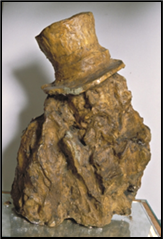 xxxxxHe knew the writer Émile Zola, and was a particularly close friend of the artist Edgar Degas, but his friendship with Rodin, which began in 1894 and was based on mutual admiration for each other’s works, came to a sudden end four years later. It would seem that Rodin objected strongly to the suggestion that he had learnt certain techniques from his Italian friend.
xxxxxHe knew the writer Émile Zola, and was a particularly close friend of the artist Edgar Degas, but his friendship with Rodin, which began in 1894 and was based on mutual admiration for each other’s works, came to a sudden end four years later. It would seem that Rodin objected strongly to the suggestion that he had learnt certain techniques from his Italian friend.
xxxxxRosso was born in Turin but worked mainly in Milan. In the early years of his career he lived in abject poverty, but his fame and fortune steadily grew after his first major exhibition, held in Paris in 1889, and over the next fifteen years he exhibited his works in major cities across Europe and in New York. His work was particularly well received in France, whilst in Italy his personal style had a marked impact upon Italian sculpture.
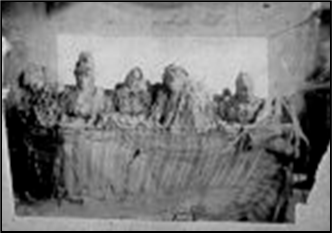
xxxxxIllustrated here are his The Laughing Child (left above), The Caretaker (right above), a Self-portrait (above), and his Impression in an Omnibus (right). The last-named work was an unusual image on the border between sculpture and painting. It was clearly based on The Third Class Railway Carriage, the work of the French painter and sculptor Honoré Daumier, completed in 1864. Unfortunately it was damaged beyond repair when in transit to Venice in 1887, and only this poor quality photograph remains.

xxxxxThere followed the nude figure of Victor Hugo. This was rejected out of hand and it was not until 1909 before a second version, nude but seated, was accepted. Worse was to come. The large sculpture of Honoré de Balzac, completed in 1897 after a great deal of research, was regarded by Rodin as one of his finest works (illustrated above). A towering figure, clothed in a long cloak and with a large, impressive head, somewhat resembled an historic monolith - anticipating modern art - but the society that commissioned it saw no merit in it. The response was one of outrage and disbelief. Indeed, such was the furore that this powerful image aroused that Rodin was obliged to employ the lawyer Georges Clemenceau (the future prime minister of France) to defend his case. In the event, the monument was not erected in Paris until 1939. Meanwhile his portrayal of the landscape artist Claude Lorrain was met with violent protest, as was his monument to the Argentinian president Domingo Sarmiento, erected in Buenos Aires.
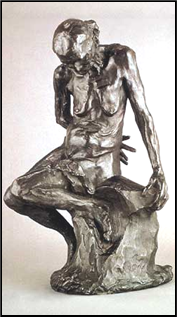 xxxxxSuch virulent opposition is not difficult to understand. These works, and many of his others, broke free from the idealized figures of antiquity and the beauty of Baroque then in vogue. As a consequence they offended an art world and a general public that was taken by surprise. Rodin exerted a new boldness of style and expression which sought to capture, be it through texture, modelling or delicacy of form, the inner strengths and weaknesses of his subject, their human qualities rather than a mere reproduction of their physical form. His realism - so real, in fact that it was at first thought to be achieved by deceit - was, in essence, the product of a psychological study, not an attempt at a superficial likeness. And in order to achieve this he would often distort the figure - as in the case of his portrayal of Balzac - in order to show its characteristics. This “expressive naturalism”, as it came to be called, was achieved by the deep chiselling of features and a detailed, irregular texture, both of which caught the variations of light and gave the subject a feeling of life and movement. In this respect his art was a three-dimensional form of Impressionism. Such treatment is to be seen to stunning effect in works such as The Thinker and The Old Woman (illustrated here), whilst beauty, delicacy and sensuality were achieved by a polished surface and pleasing lines, as in The Kiss. In bringing a new vigour and a new direction to the art of sculpture - the trend towards modern concepts - he was a genius ahead of his time.
xxxxxSuch virulent opposition is not difficult to understand. These works, and many of his others, broke free from the idealized figures of antiquity and the beauty of Baroque then in vogue. As a consequence they offended an art world and a general public that was taken by surprise. Rodin exerted a new boldness of style and expression which sought to capture, be it through texture, modelling or delicacy of form, the inner strengths and weaknesses of his subject, their human qualities rather than a mere reproduction of their physical form. His realism - so real, in fact that it was at first thought to be achieved by deceit - was, in essence, the product of a psychological study, not an attempt at a superficial likeness. And in order to achieve this he would often distort the figure - as in the case of his portrayal of Balzac - in order to show its characteristics. This “expressive naturalism”, as it came to be called, was achieved by the deep chiselling of features and a detailed, irregular texture, both of which caught the variations of light and gave the subject a feeling of life and movement. In this respect his art was a three-dimensional form of Impressionism. Such treatment is to be seen to stunning effect in works such as The Thinker and The Old Woman (illustrated here), whilst beauty, delicacy and sensuality were achieved by a polished surface and pleasing lines, as in The Kiss. In bringing a new vigour and a new direction to the art of sculpture - the trend towards modern concepts - he was a genius ahead of his time.
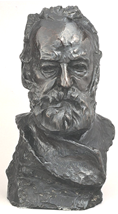 xxxxxHowever, despite the criticism levelled at his works - and in many ways because of it - Rodin’s reputation grew, and it had became firmly established by the Exposition Universelle, held in Paris in 1900. This featured a pavilion containing over 160 of his sculptures and drawings, a display that confirmed his status as a sculptor of international
xxxxxHowever, despite the criticism levelled at his works - and in many ways because of it - Rodin’s reputation grew, and it had became firmly established by the Exposition Universelle, held in Paris in 1900. This featured a pavilion containing over 160 of his sculptures and drawings, a display that confirmed his status as a sculptor of international 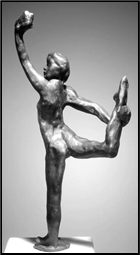 fame. He had come to be regarded as a modern Michelangelo, but from this time onwards his work was frequently on a smaller scale. For the most part he now produced busts of the rich and the famous, including Victor Hugo (illustrated), George Bernard Shaw and Gustave Mahler; made numerous studies of ballet dancers in his quest to capture spontaneous movement; and added considerably to his store of drawings.
fame. He had come to be regarded as a modern Michelangelo, but from this time onwards his work was frequently on a smaller scale. For the most part he now produced busts of the rich and the famous, including Victor Hugo (illustrated), George Bernard Shaw and Gustave Mahler; made numerous studies of ballet dancers in his quest to capture spontaneous movement; and added considerably to his store of drawings.
xxxxxMeanwhile his large house at Meudon on the outskirts of Paris, bought in 1896, became something of a factory, a huge workshop where, under his guidance, some 50 assistants produced works in bronze and marble. Orders for portrait busts came from all over Europe and the United States, and distinguished visitors to Meudon included the British King Edward VII in May 1908. It was there, following a rapid deterioration in his general health and mental state, that Rodin died in 1917. Many attended his funeral, and a cast of The Thinker was placed next to his tomb.
xxxxxIn addition to his thousands of busts, figures and sculptural fragments, Rodin painted in oils and watercolour, worked on book illustrations, and produced thousands of prints and drawings in chalk or charcoal, many of which were mildly erotic. He also published a book on the Cathedrals of France in 1914. In a career spanning 50 years he came to know many of the writers and artists of his day. In 1789 he visited the impressionist painter Claude Monet at Giverny - where he met Paul Cézanne - and through his friendship with the English poet William Henley he came to know, among others, Robert Louis Stevenson, Robert Browning and George Bernard Shaw. He greatly admired the poetry of Charles Baudelaire - his Flowers of Evil influenced his design for the Gates of Hell - and he was particularly drawn to the works of the painters Van Gogh and the sixteenth century artist El Greco, a painter noted for his distorted figures.
xxxxxIncidentally, Rodin’s artistic career was briefly interrupted on two occasions. In 1862, following the death of his sister, he became deeply distressed and withdrew to a monastery for a short time. Then with the outbreak of the Franco-Prussian War in 1870 he served in the National Guard for several months before being discharged because of poor eyesight. ……
Xxxxx……xxIn 1879 his former master Carrier-Belleuse became director of the Sèvres porcelain factory, and for a time Rodin worked there as a designer. ……
Xxxxx……xxWhen a bronze version of The Kiss was sent to the World’s Columbian Exposition in Chicago in 1893 it was considered too risqué for public display. It was put into a side chamber and seen only by request! ……
Xxxxx……xxIn 1903 Rodin was elected president of the International Society of Painters, Sculptors and Engravers (following on from James Whistler) and, four years later, along with the French composer Camille Saint-Saëns and the American novelist Mark Twain, he was awarded an honorary doctorate at Oxford University. ……
xxxxx……xxRodin donated all his works and his considerable art collection to the state. Today there are two Rodin museums in France, one at his house in Meudon, just outside Paris, and the other at Hôtel Biron, a house he once rented in the city itself. All the major museums in the world have copies of his works, and museums dedicated to his sculptures are to be found at Philadelphia, San Francisco and Tokyo. ……
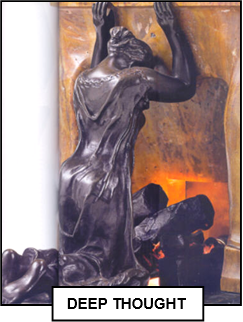 xxxxx…… Onexof Rodin’s love affairs was with a young woman named Camille Claudel (1864-1943). She modelled for him and became his mistress over a ten-year period. He taught her sculpture and she developed a rare talent. She is especially remembered for her passionate Waltzing Couple of 1889, her bust of Rodin in 1892, and the Age of Maturity, commissioned by the state in 1894. Later works included The Wave series, symbolising the force of nature, and Deep Thought, a moving and disturbing piece (illustrated). Soon after these works she had a mental breakdown and spent the last thirty years of her life in an asylum. When We Dead Awaken, the last play by the Norwegian playwright Henrik Ibsen, was based upon her relationship with Rodin.
xxxxx…… Onexof Rodin’s love affairs was with a young woman named Camille Claudel (1864-1943). She modelled for him and became his mistress over a ten-year period. He taught her sculpture and she developed a rare talent. She is especially remembered for her passionate Waltzing Couple of 1889, her bust of Rodin in 1892, and the Age of Maturity, commissioned by the state in 1894. Later works included The Wave series, symbolising the force of nature, and Deep Thought, a moving and disturbing piece (illustrated). Soon after these works she had a mental breakdown and spent the last thirty years of her life in an asylum. When We Dead Awaken, the last play by the Norwegian playwright Henrik Ibsen, was based upon her relationship with Rodin.
xxxxxTwo sculptors were particularly influenced by Rodin during his lifetime. ThexFrenchman Antoine Bourdelle (1861-1929) worked as an assistant to Rodin from 1893, and Rodin much admired his work. He is especially remembered today for his series of portraits and masques of the German composer Ludwig van Beethoven, begun in 1888, and his Monument to the Defenders of Montauban, a work commemorating the resistance put up by the town during the Franco-Prussian War. And thexAmerican sculptor George Grey Barnard (1863-1938) was much influenced by the works of Rodin in his early years. His works included The Boy (1885), Brotherly Love (1887), and Two Natures (1894). His colossal statue of Abraham Lincoln, was completed in 1917, a copy of which is in Manchester, England.







 xxxxxAuguste Rodin, the foremost sculptor of the 19th century and early 20th century, was born in Paris, son of a clerk in the city’s police department. From early childhood he showed a marked ability at drawing, and at the age of 14 attended La Petite École, a school specialising in the training of craftsmen and decorative artists. He showed promise at this stage, notably in sculpture, but on completing his training in 1857 he made three unsuccessful attempts to gain entrance to the École des Beaux Arts, and was finally obliged to go out and earn a living. Forxthe next thirteen years he worked as an assistant to a number of decorators and ornamentalists, including the French sculptor Ernest Carrier-
xxxxxAuguste Rodin, the foremost sculptor of the 19th century and early 20th century, was born in Paris, son of a clerk in the city’s police department. From early childhood he showed a marked ability at drawing, and at the age of 14 attended La Petite École, a school specialising in the training of craftsmen and decorative artists. He showed promise at this stage, notably in sculpture, but on completing his training in 1857 he made three unsuccessful attempts to gain entrance to the École des Beaux Arts, and was finally obliged to go out and earn a living. Forxthe next thirteen years he worked as an assistant to a number of decorators and ornamentalists, including the French sculptor Ernest Carrier-
 xxxxxIn the same year he began work on The Gates of Hell (illustrated), a monumental bronze door, commissioned by the French government for the planned Museum of Decorative Arts in Paris. Doubtless inspired by Ghiberti’s bronze doors of 1423 (H6), he originally took as his theme Dante’s Inferno, but, following a visit to London in 1881, during which he saw many Pre-
xxxxxIn the same year he began work on The Gates of Hell (illustrated), a monumental bronze door, commissioned by the French government for the planned Museum of Decorative Arts in Paris. Doubtless inspired by Ghiberti’s bronze doors of 1423 (H6), he originally took as his theme Dante’s Inferno, but, following a visit to London in 1881, during which he saw many Pre-
 xxxxxA contemporary sculptor who was a friend of Auguste Rodin for a time, and shared some aspects of his innovative style, was the Italian Medardo Rosso (1858-
xxxxxA contemporary sculptor who was a friend of Auguste Rodin for a time, and shared some aspects of his innovative style, was the Italian Medardo Rosso (1858- xxxxxHe knew the writer Émile Zola, and was a particularly close friend of the artist Edgar Degas, but his friendship with Rodin, which began in 1894 and was based on mutual admiration for each other’s works, came to a sudden end four years later. It would seem that Rodin objected strongly to the suggestion that he had learnt certain techniques from his Italian friend.
xxxxxHe knew the writer Émile Zola, and was a particularly close friend of the artist Edgar Degas, but his friendship with Rodin, which began in 1894 and was based on mutual admiration for each other’s works, came to a sudden end four years later. It would seem that Rodin objected strongly to the suggestion that he had learnt certain techniques from his Italian friend. 

 xxxxxSuch virulent opposition is not difficult to understand. These works, and many of his others, broke free from the idealized figures of antiquity and the beauty of Baroque then in vogue. As a consequence they offended an art world and a general public that was taken by surprise. Rodin exerted a new boldness of style and expression which sought to capture, be it through texture, modelling or delicacy of form, the inner strengths and weaknesses of his subject, their human qualities rather than a mere reproduction of their physical form. His realism -
xxxxxSuch virulent opposition is not difficult to understand. These works, and many of his others, broke free from the idealized figures of antiquity and the beauty of Baroque then in vogue. As a consequence they offended an art world and a general public that was taken by surprise. Rodin exerted a new boldness of style and expression which sought to capture, be it through texture, modelling or delicacy of form, the inner strengths and weaknesses of his subject, their human qualities rather than a mere reproduction of their physical form. His realism - xxxxxHowever, despite the criticism levelled at his works -
xxxxxHowever, despite the criticism levelled at his works - fame. He had come to be regarded as a modern Michelangelo, but from this time onwards his work was frequently on a smaller scale. For the most part he now produced busts of the rich and the famous, including Victor Hugo (
fame. He had come to be regarded as a modern Michelangelo, but from this time onwards his work was frequently on a smaller scale. For the most part he now produced busts of the rich and the famous, including Victor Hugo ( xxxxx…… Onexof Rodin’s love affairs was with a young woman named Camille Claudel (1864-
xxxxx…… Onexof Rodin’s love affairs was with a young woman named Camille Claudel (1864-


